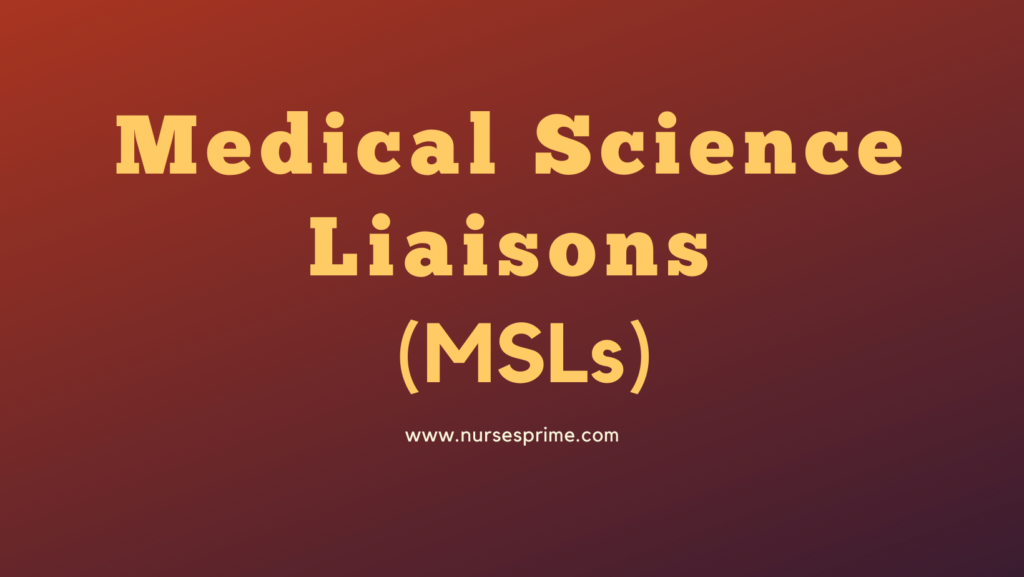Medical Science Liaisons (MSLs)
Healthful Vitality | 12/01/2021 | Medical Science Liaisons (MSLs).

These are health care consultants who work in specific domains, such as biotech industries, pharmaceuticals, medical device manufacturing industries, CRO, and other healthcare organizations as experts in clinical research trends and specific products. While Medical science liaisons (MSLs) do not essentially need to be licensed medical practitioners, they must have advanced medical knowledge as well as scientific training.
In general, medical science liaisons (MSLs) focus on specific therapeutic areas (Cardiology, Oncology, Hematology, CNS, Women’s and Children Health Care) and disease conditions (Hypertension, Rheumatoid Arthritis, Diabetes, etc.).
Why MSLs are Important?
Medical science liaisons (MSLs) play a crucial role in the success of an organization. Indeed, they work throughout the lifecycle of a product to ensure that products are manufactured and utilized effectively. Although, they serve as scientific peers within the medical community; however, their primary role is to develop and maintain peer-to-peer relationships with Key Opinion Leaders (KOLs) at leading academic institutions as well as clinics.
Who are the MSLs?
Medical science liaisons (MSLs) may in fact possess an M.D., D.O., or other postgraduate degrees like a PharmD, Ph.D., Master of Business Administration (e.g., a healthcare-focused MBA), Master of Science in the life sciences, or an advanced degree in dentistry or nursing. The Medical Science Liaison Society reports that more than 90% of MSLs have some kind of a doctorate degree.
The Progress in the MSL Profession
Since 1967, when being established by Upjohn Pharmaceuticals, Medical science liaisons (MSLs) have achieved more significance to the success of the organizations that employ them.
Consequently, the profession has expanded exponentially over the last decade. According to a recent MSL Society survey, about 68% of higher management of companies are planning to expand the size of their MSL teams in the future.
What Do Medical Science Liaisons Do?
The major roles and responsibilities of MSLs may vary widely, depending on multiple factors including:
- The Therapeutic Area in which they provide their support
- The stage where a product is at in its lifecycle
- The geographical area of the role
- The type of the company i.e. Pharmaceuticals or Medical Device manufacturing.
The responsibilities of MSLs typically include:
- Collaborating with external stakeholders
They play a crucial role in establishing KOL engagement plans, recognizing clinical investigators, collecting insights, communicating scientific data, making connections between external and internal stakeholders, supporting research activities of external stakeholders, and responding to scientific information requests.
- Engaging with internal stakeholders
Providing training, assisting clinical research teams, and communicating with internal cross-functional teams.
How Much Do MSLs Make?
The average annual salary of Medical Science Liaisons in the U.S. is $107,510 as of October 2021, with the range between $91,480 and $127,960. Salary ranges may greatly vary based on different factors, including location, education, additional skills, certifications, experience, and the type of employer.
Career Outlook for Medical Science Liaisons
The U.S. Bureau of Labor Statistics does not have any formal listing for medical science liaisons. However, they track statistics for relevant professions like medical scientists. According to the U.S. Bureau of Labor Statistics, there were about 130,000 medical scientists in 2018. The BLS estimates the growth of this profession by 8% from 2018 to 2028. It is expected that more MSLs will be required due to the increased aging population and higher demands for treating chronic conditions.
(Related Article: Nuclear Medicine Technologist)
